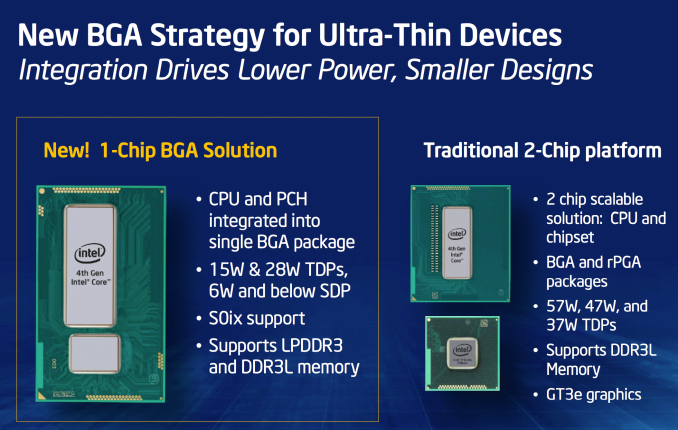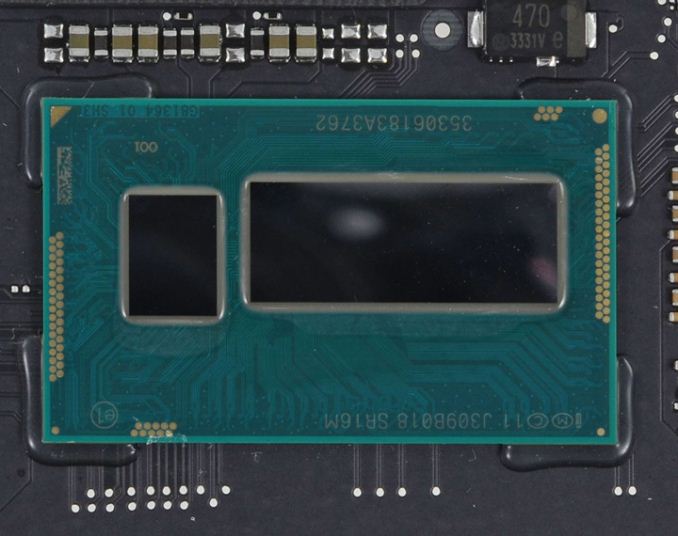The 2013 MacBook Air Review (13-inch)
by Anand Lal Shimpi on June 24, 2013 12:01 AM ESTThe CPUs
Apple keeps things simple across the 2013 MacBook Air lineup by configuring both 11 and 13-inch models with the same base CPU: a Core i5-4250U.
To understand Apple’s CPU choice, you have to understand that Apple is primarily concerned about improving battery life this generation. The line between MacBook Air and MacBook Pro has to be well defined. The Air is about portability, while the Pro is about performance. When faced with a power/performance tradeoff, it’s clear on which side of the fence Apple will fall whenever the MacBook Air is concerned.
| Apple 2013 MacBook Air CPU Comparison | |||||
| 1.3GHz dual-core | 1.7GHz dual-core | ||||
| Standard On | 11 & 13-inch MBA | Optional on Both | |||
| Intel Model | Core i5-4250U | Core i7-4650U | |||
| Base Clock Speed | 1.3GHz | 1.7GHz | |||
| Max SC Turbo | 2.6GHz | 3.3GHz | |||
| Max DC Turbo | 2.3GHz | 2.9GHz | |||
| L3 Cache | 3MB | 4MB | |||
| TSX-NI | No | Yes | |||
| TXT | No | Yes | |||
| AES-NI | Yes | Yes | |||
| VT-x/VT-x EPT | Yes | Yes | |||
| VT-d | Yes | Yes | |||
| TDP | 15W | 15W | |||
| Processor Graphics | Intel HD 5000 | Intel HD 5000 | |||
| GPU Clock (Base/Max) | 200/1000MHz | 200/1100MHz | |||
The lower base clock alone shouldn’t mean much, but the max TDP of the CPUs in the new MacBook Air falls as well - from 17W down to 15W. The thermal limit is even more dramatic since with Haswell ULT, the 15W includes the CPU/GPU as well as the on-package PCH. In Ivy Bridge the PCH was off package and wasn’t included in the 17W TDP.
Max turbo clocks are identical between the Haswell ULT CPUs Apple picked this round and the Ivy Bridge models before, but with a lower TDP it’ll be harder to always sustain the same frequencies given the right workload.
Haswell does feature a not insignificant gain in IPC compared to Ivy Bridge, which should help offset the power constraints that could otherwise force a larger regression in performance.
Both 2013 MBAs ship with the same CPU by default, and both can be upgraded to the same higher end SKU: a Core i7-4650U. The 4650U retains the same 15W TDP as the i5-4250U, but it increases its base clock speed to 1.7GHz and max turbo to 3.3GHz. The L3 cache also grows from 3MB to 4MB. All in all, this should be a very healthy upgrade in performance. Intel likely maintains the same TDP by binning for power; the i7-4650U is probably capable of running at higher frequencies without any appreciable increase in voltage. The max GPU clock also goes up by 10%.
Haswell ULT, Courtesy iFixit
What's arguably coolest about the i7-4650U is it enables Haswell's Transactional Synchronization Extensions (TSX-NI), a feature which is unfortunately disabled on the i5-4250U. I don't suspect this will matter much for most MBA users, but anyone looking to play around with Haswell's TSX instructions will want to opt for the higher end SKU. The upgrade costs $150 regardless of base model. Intel charges $454 for the i7-4650U and $342 for the i5-4250U, a difference of $112; Apple is adding another $38 onto the 1KU pricing, which isn't unreasonable.
Many have asked me what the impact of the i7 will be on battery life. I'm hoping to get my hands on an i7 based machine when I return from the UK in a week, but for those of you making immediate decisions I'll offer the following. Sustained operation at higher frequencies will likely draw more power, and negatively impact battery life. Light to medium workloads will enjoy a mix of race to sleep benefits as well as higher power consumption under load. Idle power should be roughly similar between the parts however. For most workloads I'd expect a modest impact to battery life, but it won't be enough to regress to 2012 levels of battery life. All of this is said without knowing key details like operating voltage for most 4650Us. I plan on addressing that shortly.












233 Comments
View All Comments
sunman42 - Tuesday, June 25, 2013 - link
"Until OS X Mavericks arrives, you'll have to make sure to pay attention to things like background web browser tabs running Flash from killing your battery life." Or you could just do without Flash, or use Click to Flash, and avoid many very nasty bugs, constant security patches, and battery vampirism. Just, as they say, sayin'.jcbottorff - Tuesday, June 25, 2013 - link
The use of a 64K TCP window may be a feature not a bug. I say this because there often is a need to minimize latency of small packets, like used for Voip or other streaming media. With a TCP window size of 64K, on a 6 Mbps DSL connection, a packet queue of 64Kb takes about 85 milliseconds to drain. This means if you did a 64K TCP send (which optimally is one request to the NIC, with the NIC doing TCP segmentation), followed by a Voip UDP packet, it could be 85 milliseconds before the Voip packet goes out the DSL modem. If the TCP window were 256K, the latency would climb to 85*4=340 milliseconds, an unacceptable delay for Voip. It is possible to use varying TCP window sizes based on the current mix of network activity. Like for example, if you have a Voip call active and you have a TCP connection to a server on the Internet, over DSL modem, you may want to limit the TCP window size. If you only have a file sharing connection to a server on the local subnet, you can use a large window size. It's a lot more complex than just changing one number, unless you don't care about things like streaming media working correctly. OS designers often have to compromise, such that nobody is totally happy, but nobody is really upset either. I think the real question is how well the OS dynamically adjusts things under varying conditions to always give the most optimal user experience possible.SimonO101 - Tuesday, June 25, 2013 - link
Can we expect even greater battery life once OS X Mavericks comes online?darwinosx - Tuesday, July 9, 2013 - link
Yes. But if I said I knew this for sure I might be violating an NDA.trip1ex - Tuesday, June 25, 2013 - link
Also they should let you sync your MBA to a Mac/PC like an iOS device to help mitigate the 128gb storage in the base model. Or even let you sync to an external drive. I would love an elegant way to offload media particularly.darwinosx - Tuesday, July 9, 2013 - link
There are MANY ways to do this.niico - Tuesday, June 25, 2013 - link
I run Windows 8 in a Parallels VM on Mac OS 10.8 - this is my usual setup. If you're looking for a more strenuous battery test I suggest a VM. This often keeps the CPU at 30-50% even when both OS's are idle.It is an increasingly common use case - and many users would be interested to see the battery performance, specially on Haswell.
ctwise - Monday, July 1, 2013 - link
I run Windows 7 in VMWare Fusion on OS/X 10.8 as a SQL Server provider for development. I'm not sure if it's a difference between use cases for VMs or a Parallels vs. VMWare, but I rarely see even a single percentage of usage by my Windows VM.Oscarcharliezulu - Wednesday, June 26, 2013 - link
Good review, usual d$&khead comments from apple haters. I love hardware, all brands and watching it improve, it never gets old. Have recently switched to OSX on a 27" iMac at home for the fun of it and have to say now I'm familiar with it I prefer it to windows. Might switch my work laptop to a MBA, use it rather than my iPad+keyboard that I generally also carry around.akdj - Thursday, June 27, 2013 - link
Lol...exactly how it started for me...some 8 years ago now. Twenty years on PC (first computer was actually an Apple IIe)--& my wife was graduating with her masters degree. She'd been talking about a friend's MacBook for a few months...for her grad gift, I got her one of the old, plastic white MacBooks...my 8 year old son is still using that computer...in stock form daily!That first month...it was hard for me to give it up to her. I loved it. Loved OSx. Within six weeks I'd bought my own 15" MBP. Haven't bought a Windows machine since. For a couple years, I used bootcamp as there were a couple of programs that were only on Windows that I needed. They've since been ported to OSx and I've no need any longer for anything other than OSx
Kinda bums me out I waited as Long as I did. It's amazing having a house full of computers that NEVER need support!